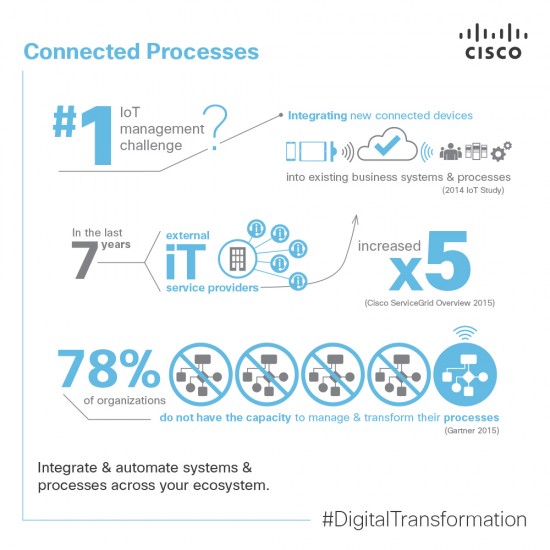































In a recent blog written by Mala Anand, she discussed how hyper-distribution of assets in organizations is creating demands for new insights and enabling new interactions and experiences across every industry. Mala shared how our hyper-distributed world has created remote centers of data which require access by people and processes within and beyond your organization. And, it is your ability to connect data, connect processes and connect experiences that will be the cornerstone to succeeding in this new digital era. Through this blog, I want to focus on some of the top considerations when deploying and integrating systems and processes in today's complex hyper distributed environment.
Surviving in this hyper-distributed and digital era requires new levels of business agility and re-imagining existing processes. Yet there exists a big divide. A report published by Gartner Research Consulting-Cisco IoE Engagement Findings, December 2014 states: "78% of organizations have not yet established the capability to manage and transform processes across different parts of their organization." This transformation requires extending the value of existing infrastructure; integrating partner ecosystems to streamline and automate processes within your enterprise and across your value chain of partners, service providers and customers.
 Figure 1: The importance of integration.
Figure 1: The importance of integration.Here are some key considerations as you embark on this journey:
1. Moving beyond Request driven to Event Driven Systems
Classic Service Oriented Architecture (SOA) allows an exchange of information within and across enterprises. It enhances the ease of information flow, modularity and reusability. However as we move from a distributed client-server model to hyper-distributed world, enterprises need to think of speed and fluidity in every aspect of work. Sensing and responding to business events from people and systems regardless of where they are located becomes paramount. Today's complex hyper- distributed environments require that we move beyond SOA to more event-driven architectures that enable more flexible systems and processes that support dynamic business conditions. Today's architectures must enable massive scalability that go beyond multiple point-to-point communications to an approach which is based on events occurring and support asynchronous process communications.
2. Integration of Everything
Today's digital era not only requires connecting things but connecting the data and insights generated from those things with people and processes. This expanded view of connectivity requires seamless integration of applications, data, infrastructure, and business processes within organizations and across ecosystems. As traditional App-to-App integrations (A2A) approaches evolve to support hybrid cloud environments, new integrations are needed from the application layer to the infrastructure layer (A2I). This will bring the power of Any-to-Any integrations that leverage the programmability of elastic infrastructure to automate integration efforts and reduce the time to deploy.
3. Programmability of Everything
The notion of service externalization is well understood. Taking that concept and applying it for any enterprise asset (apps, data, infrastructure and things) is powerful shift in paradigm that enables process automation. In this API-driven economy, APIs are not only critical to expose your assets securely to partners and customers but also essential in gaining return on existing assets. You need a robust API management capability that addresses the entire lifecycle of an API: design, simulate, validate, publish, govern and retire.
4. Security, Policy and Governance
As an enterprise ventures into digitization, applications, data and processes span across technology and business boundaries -on/off prem, B2B etc. The need to look at processes end-to-end and share information across your value chain requires a new approach to security and governance. The integrations to optimize operations or customer experience often involve highly sensitive information and requires policy based access to assets including securing the information flow through features like SSO, identity management and credential management, identity and access management and API governance.
5. Experience-centric approach
The final consideration helps tie all the pieces together: the need for an experience-centric approach. At the core, the business outcomes from operational improvement initiatives in any industry are powered by new interactions and experiences. Because of that, the solution requirements need to be informed by the customers, patients and citizens participating in the processes you are connecting. These requirements define how this growing number of users need to access these centers of data and must address people's increased appetite to work using the modalities they are comfortable with -smartphones, touchscreens, laptops. And it is not just about the access to the information, but delivering relevant and timely information so they can make informed decisions. simple terms, it is about delivering the information that a person needs, when they need it, in the best way for them to consume it, based on who they are and where they are.
We live in an age of connectivity that is accelerating the pace at which we get work done. Connecting processes by connecting systems and people and automating work is the next frontier for connectivity. Connected processes include software platforms from Cisco that allow you integrate, automate and securely connect across disaggregated, distributed applications and infrastructures within and across your eco-systems.
In future blogs I will dive into these considerations and provide examples of leading organizations who are putting these principles into practice.
 Tags chauds:
Internet of Everything (IOE)
IoE
digital business transformation
integration
Hyper distributed
Service Oriented Architecture
Tags chauds:
Internet of Everything (IOE)
IoE
digital business transformation
integration
Hyper distributed
Service Oriented Architecture